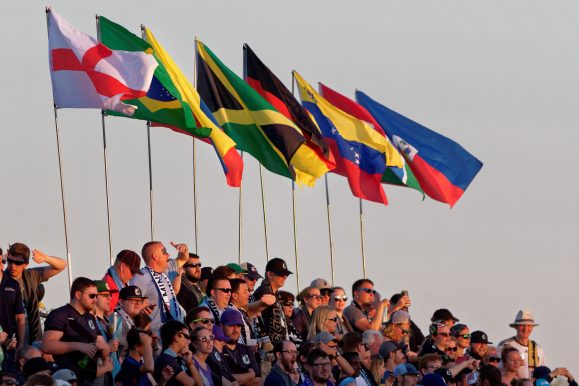On July 12, the New York Times published an article by Jay Caspian Kang that puts forward the following thesis: MLS supporters culture has co-opted aspects of European (by which he means English) football culture historically tied to racist hooliganism. He also adds that this Euro-philia has turned away Latinos (by which he means Mexicans) as potential fans of MLS. Take it from a brown skinned immigrant to America from a country oppressed by the English for close to a hundred years: Kang’s argument is complete and utter rubbish.
Kang’s article glosses over the very real diversity-related issues in our stands by pointing the finger at the songs we sing rather than our lack of outreach. The problems with Kang’s piece crop up early and before we get to the meat of his thesis. While recounting what he saw at a Seattle Sounders game at CenturyLink Field, Jay tells us about signs denouncing racist speech that he saw in the stadium. Jay says:
“Many stadiums in Europe carry such signage for obvious reasons, but why would they be needed in a supposedly progressive city on the West Coast of the United States?”
To me these signs say, “Our stadium is a space where the authorities take a tough, proactive stand in regards to racism.” We don’t live in a post-racism society and people of color like me do still have to contend with racist speech. I saw a very similar sign in Indianapolis recently when I traveled to an away game there.
As a person of color entering a space where the vast majority of people are white, seeing these signs made me feel safer and more comfortable. They told me that most of the people around me shared my distaste for bigotry. It was a sign (pun intended) that I wasn’t as much of an “other” in this space as it may have seemed on the surface. This sort of proactive signage isn’t exclusive to soccer stadiums either. Walk into most progressive American college campuses and you’ll see signs announcing “Safe Space” or “Ally” on the doors of faculty and staff.

Interestingly, when Kang briefly picks up on a truly problematic part of soccer culture in this country, he misses the mark entirely. In the article he mentions this chant:
‘Take ’em all, take ’em all, put ’em up against a wall and shoot ’em! Short and tall, watch ’em fall. Come on boys, take ’em all.’
Kang says the song is problematic due to its association with racist Englishmen. I’d counter that few people in America would know it’s sung at British National Party meetings. Instead the vast majority of U.S. listeners would think it’s a shockingly inappropriate number given the backdrop of the America’s persistent problems with domestic mass shootings and gun violence.
Prominent New York-based soccer website Empire of Soccer recently published a powerful piece calling on supporters groups to retire ‘Take ‘Em All’ in light of its domestic context. Unfortunately, down the road at the New York Times, Jay Caspian Kang didn’t make the connection and didn’t see the steps U.S. soccer supporters were internally taking to rectify the problem.
Instead, he moves on to paint us a picture of the racist thuggery in the English stands circa 1990 and how domestic supporters have taken on “a dream of an ultimately monochromatic gathering in which thousands of white men can brawl (but safely and without guns!) in the streets and drunkenly sing Phil Collins melodies in pubs, lending a hooligan snarl to a white, suburban culture.”
Soccer is intrinsically linked to politics and socioeconomics worldwide in a way that breeds violence between supporters.
But this ignores the fact that soccer hooliganism has very much been part of the culture of the game outside of Europe as well. Immigrants from other countries, Argentina for example, know soccer violence all too well and it isn’t “thousands of white men” doing the brawling. Soccer is intrinsically linked to politics and socioeconomics worldwide in a way that breeds violence between supporters. Even hate isn’t exclusive to European soccer; instances of racism and homophobia have cropped up in Brazilian and Mexican soccer.
Perhaps the problem, then, isn’t the songs being sung but rather the socioeconomics of the sport in America and the lack of effort made to attract a more diverse audience to soccer stadiums. Appreciation for domestic soccer is not a default position in American culture; the people who play the sport here (and their families) are the ones who come away with appreciation and interest in domestic soccer.
The U.K.’s Guardian recently published a very poignant piece about how U.S. soccer’s pay-to-play developmental system is heavily favoring wealthy players who are predominantly white. If the academies making money and their members are predominantly white, then that’s going to be reflected in where team ticket sales offices focus their outreach. The article also describes how soccer in America is seen as a “white, suburban” sport and how that keeps non-white families outside the sphere of the domestic sport. Come gameday it’s no surprise, then, that the stands at so many domestic club matches see crowds that are indeed more homogeneous than they ought to be.
There is a strong case to be made that our groups, teams, and leagues need to be more proactive in seeking to bring more people of color into our stands. The Guardian article describes the “ligas Latinas around San Francisco’s East Bay,” rec leagues with players and an audience drawn from Central and South American immigrant communities. Here in Minnesota, there are Somali and Hmong soccer communities. Our teams must conduct outreach to these events and organizations and with representatives that are people of color themselves. When the red carpet is being rolled out to non-white families, it’s harder for them to dismiss domestic soccer as a “white, suburban” space. Active outreach helps new fans to feel valued as part of the domestic soccer community and supporters can be a strong asset for teams in helping convey this inclusivity and value.
When I attended several U.S. soccer games in Chicago and the Twin Cities in the non-supporters stands, I never saw anything to tie me to the experience. There was no outreach. That changed when I went to the Dark Clouds section at Minnesota United matches. These supporters (the vast majority white by the way) thumped my back, shared their beer and brats, and generally made to feel like a valued community member. That’s what made me buy a season ticket and arrange my life around attending games.
I never gave any thought to which continent’s people first waved flags like I was waving or which oppressive nation came up with ‘tifo.’ The simple camaraderie and inclusivity shown by the supporters was enough to make me give up on other hobbies and dedicate most of my free time to soccer. Jay Caspian Kang picked up on the very real issue of the lack of diversity in our stands but entirely missed the point on its causes and possible solutions. Instead of outsiders like him, we need voices of color from within our stands and team front offices to advise us on what we need to do in order to bring in a more diverse populace to our stadiums.

Leave a Reply